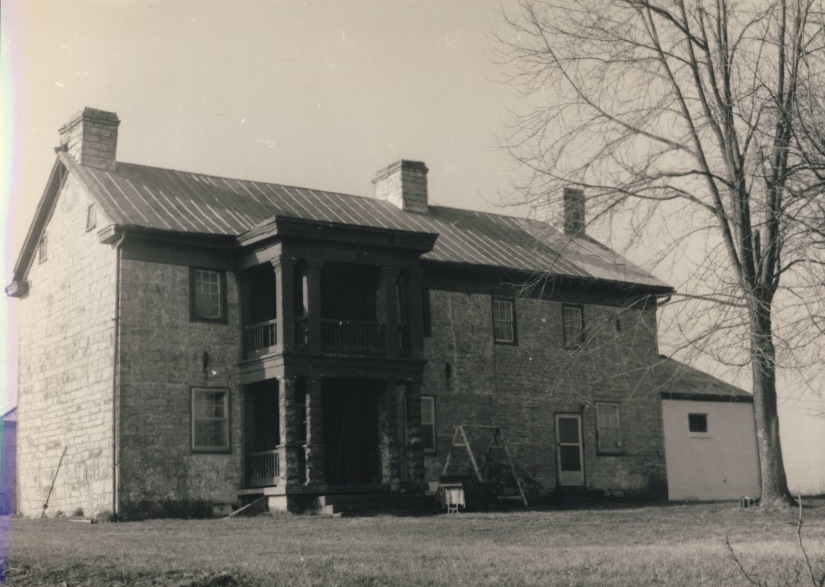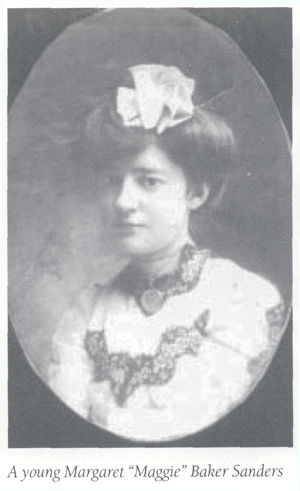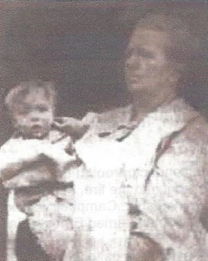
The following article by Charles Hartley originally appeared in The Pioneer News on 12 Sep 2024.
It is archived here for your reading enjoyment.
This article is dedicated to the Bullitt County Homemakers who listened to a version of it at their recent meeting. In it I will briefly describe the lives of three earlier homemakers who really made a difference.
Mary Osborne Crist
Dory Osborne and Anne Hoagland were married in Nelson County in January 1809, and a bit more than a year later their first child, a daughter they named Mary was born.
Mary Osborne was 18 when, in April 1828, she married Henry Spears Crist, son of the well-known General Henry Crist. It's possible that Mary thought she was marrying into a family with considerable wealth, or maybe not, but while her father-in-law still owned considerable land, he also was accumulating some significant debts, and his son was involved in quite a bit of this as well.

During their first dozen years together, Mary gave birth to a daughter, Laura Catherine, and two sons, William Henry and Alexander. Then in 1845 they added another daughter Mary Frances. One final child, a daughter they also named Mary, was born in 1850, but died young.
Being a farmer's wife meant that Mary not only saw to the family meals, and the sewing and mending needed to keep everyone in clothes, but also likely help tend the vegetable garden, as well as helping Henry with other farm chores. They lived in the big house that her father-in-law had built, and she was largely responsible for keeping it in order as well.
Henry Crist's name was attached to more land transactions than perhaps any other person by that time in the county's history, but he was not always a good businessman, and as the years wore on, his losses grew. By 1839, he and his son were in debt to William Newbolt, a debt they could not pay, and the court ordered the sale of their 360 acre tract where Henry lived to pay the debt.
Newbolt bought the land at auction, but Crist had the option of redeeming it by a certain date. It appears that he attempted to do so before his death in 1844, but failed to pay the complete cost. However, it appears that the balance due was paid by someone who intended to see that it remained in the hands of Mary Crist. In May 1847, Newbolt agreed to have it deeded to her and her children after her. It was expressly understood that it was not to be in the hands of her husband to prevent his creditors from gaining it to pay his debts.
In November 1849, Henry and Mary accepted the responsibility of taking charge of the county's paupers. Prior to that time, the County Court had dealt with its poor folks by assigning a neighbor to see to their needs, but with the need growing, they decided on a different approach.
The Court allotted them $250 and named 14 paupers for which they would be responsible for the next year. Their contract was renewed the following year. Then in 1851, the contract was given to Mary alone, likely indicating that they recognized who was really doing the work. She would continue supporting the paupers, year by year, until the Fall of 1856 when the job was given to James Shepherd, he being the lowest bidder.
Of Henry and Mary's children, daughter Laura Crist married Nathan Crenshaw in 1846 and their family was growing. Mary's eldest son, William Henry Crist died shortly after marrying Letitia Biggs in September 1855. Daughter Mary Frances would marry William Roby in 1858, after the death of her father in December 1856.
By the 1860 census, Mary still maintained a home for her son Alexander, and her son-in-law and daughter William and Mary Frances Roby; and the Crenshaws were living next to them. It appears that her youngest daughter had died young.
Her life drawing to a close, Mary made arrangements in October 1860 for the home place to be passed on to her remaining children. In return for deeding her life estate to her children, she was to receive yearly payments from them, and to also continue to live in her home.
Mary Crist died in February 1863, having done the best she could for her family and community.
Maggie Sanders
Our second lady was Margaret Baker Sanders who helped contribute much to the Shepherdsville community a century ago.
Mary Amelia Montague, daughter of Judge Robert S. and Margaret (Cox) Montague, was a young Taylor County teacher when she married Horace Edwin Baker in May 1882. Their first child was a daughter they named Margaret, but fondly called Maggie.

Maggie married Jack Sanders on Christmas Eve 1906, in Campbellsville. He was described in the newspaper reporting the marriage as "a school teacher at present, a lawyer by profession, and as clever a gentleman as can be found in Kentucky."
I've written about Jack Sanders during his time in Shepherdsville, but today I want to remember Maggie, his wife.
By the 1910 census, Jack and Maggie were living with his parents, along with the first two of their children. Maggie, who was a talented pianist, brought her love of music to the family.
In 1912, the family moved to Shepherdsville where Jack began his work at the local school, while Maggie kept the home of their growing family of now four children. They joined the local Baptist church where Jack was soon teaching a Bible class while Maggie contributed her talent at the piano. Two more children would join the family during their time at Shepherdsville where the family was active in the life of the community.
While it was Jack Sanders who drew much of the town's praise for his work at the school, it was Maggie who was always there at his side. Laura Frick Richardson, a 1926 S.H.S. graduate, wrote fifty years later that every school day Maggie Sanders walked to the school at noon, carrying a large basket of lunch for Jack and their children who attended the school, as there was no lunchroom at the school, so everyone provided their own
Late in his life, their son Tom Sanders wrote, "Margaret Baker Sanders was Jack's helpmate, secretary, critic, and alter ego. Maggie and Jack were musicians, and with their six children performed in educational circles as Sander's Serenaders. Maggie's avocation was the Masonic Order of the Eastern star. She became its highest officer in Kentucky (Grand Worthy Matron) in 1939. She was an excellent cook, but did not relish housekeeping. Her home was never lavishly furnished, but was filled with Jack's books and the family's musical instruments. Witty and straightforward, someone once ask her her idea of heaven. She immediately replied 'a bed to myself and no dishes to wash.' Her three daughters were all accomplished pianists (as was she) and performed on several other instruments."
After the Sanders family left Shepherdsville, they spent many years in Greensburg, building up that school, before retiring to Greenville, Kentucky where their daughter Margaret was a music teacher and band director in the local school.
With their children grown, Jack and Maggie continued to be active. The 1950 census indicates that he was still teaching math at the Greenville school, and Maggie was teaching music there as well.
I was pleased to correspond with their daughter Liz a dozen years ago when she was in her nineties and living in upper Michigan where she continued the family tradition of sharing by giving weekly piano concerts at the local library. Jack and Maggie would have been proud.
Sola Trunnell
Our third homemaker was born Isola Isadore James in 1869, the fourth child born to William and Leatitia (Rouse) James, on a farm in the Leaches District of eastern Bullitt County.
She married Joseph Trunnell in 1894, and in the 1900 census, Joe and Sola were living with her parents on the family farm. With them were two daughters: Bertha, born in 1897, and Nancy, born the next year.
A decade later they were still on the farm and had added another daughter, Hazel who was 4 years old. But, in September 1910, Joe Trunnell made arrangements with Lula Smith to take over the management of her Shepherdsville boarding house on Second Street next to the railroad tracks.
In October 1912, Mrs. Smith sold the place to C. F. Troutman, part-owner of the nearby Troutman's Mammouth Store. The Trunnells continued to run the place, and in 1918 they bought it for themselves.

While Joe Trunnell turned his hand to the real estate business, it was Sola who managed the boarding house and made a home for her daughters.
She gained a bit of recognition during the 1917 December train wreck outside their home when a Louisville newspaper printed a picture of her holding the baby that had been found in the snow following the crash. The child had been brought to her to care for until its parents could be located.
Joe and Sola continued to maintain a family home for their daughters. By 1920, her daughters Bertha and Nancy were in their early twenties, having finished their schooling, and Bertha was now a teacher herself, while Nancy was working in an insurance office as a bookkeeper. Hazel, now 14, was attending school at Shepherdsville, in the same class with Maggie Sanders' daughter.
Bertha taught in Bullitt County schools until 1924 when she moved to Auburndale Elementary in Jefferson County. She was teacher and then principal there until 1955 when she became principal of the then-new Kenwood Elementary where she stayed until her retirement in 1967. That October the new elementary school on St. Andrew's Church Road was named in her honor. She stayed in Louisville during the school years, but returned home to Shepherdsville each summer.
Nancy married Wilbur Strange and they had two children, Joseph and Ruth. Wilbur died of pneumonia, leaving Nancy a widow with children to rear. She returned home with her children to the comforting arms of her parents.
Nancy went to work as a deputy in the Circuit Clerk's office, and then in 1937 she was elected as Bullitt County's Circuit Court Clerk, a post she filled for 44 years until her retirement in 1981.
Hazel married Curtis Smith and they had two daughters, Irma Dell and Mary Curtis, who both became talented musicians. Mary Curtis related that she was born in the Trunnell home during the 1937 flood, and after her birth they put planks from the stairs to the transom over the front door to take her out to the boat in the flood water.
Joe and Sola lived into their eighties, maintaining a welcoming home for their daughters and grandchildren. Finally death claimed each of them, Sola in 1952, and Joe in 1955, but their home lived on with Bertha and Nancy living there the rest of their lives.
And there you have it, three homemakers, perhaps typical of many of you, who lived their lives making homes for their families, while helping make their communities a better place to live.
Copyright 2024 by Charles Hartley, Shepherdsville KY. All rights are reserved. No part of the content of this page may be included in any format in any place without the written permission of the copyright holder.
The Bullitt County History Museum, a service of the Bullitt County Genealogical Society, is located in the county courthouse at 300 South Buckman Street (Highway 61) in Shepherdsville, Kentucky. The museum, along with its research room, is open 10 a.m. to 4 p.m. Monday through Friday. Saturday appointments are available by calling 502-921-0161 during our regular weekday hours. Admission is free. The museum, as part of the Bullitt County Genealogical Society, is a 501(c)3 tax exempt organization and is classified as a 509(a)2 public charity. Contributions and bequests are deductible under section 2055, 2106, or 2522 of the Internal Revenue Code. Page last modified: 22 Sep 2024 . Page URL: bullittcountyhistory.org/memories/homemakers.html